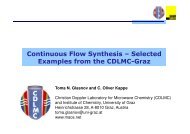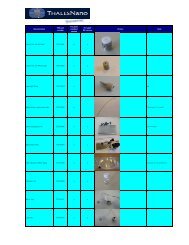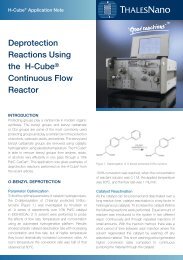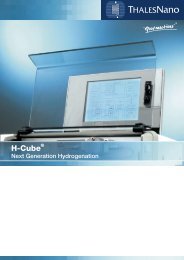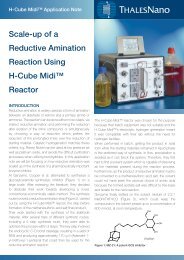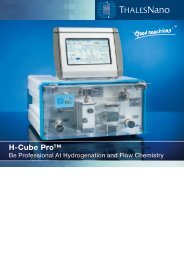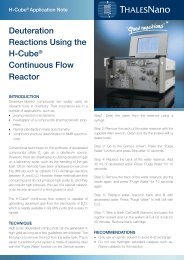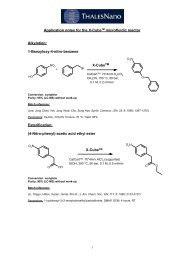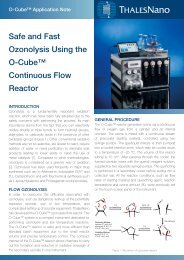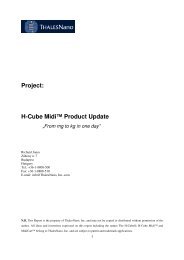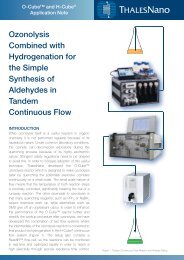Sonogashira and Suzuki Reactions Using H-Cube ... - ThalesNano
Sonogashira and Suzuki Reactions Using H-Cube ... - ThalesNano
Sonogashira and Suzuki Reactions Using H-Cube ... - ThalesNano
Create successful ePaper yourself
Turn your PDF publications into a flip-book with our unique Google optimized e-Paper software.
H-<strong>Cube</strong> ® Application Note<br />
<strong>Sonogashira</strong> <strong>and</strong><br />
<strong>Suzuki</strong><br />
<strong>Reactions</strong><br />
<strong>Using</strong> H-<strong>Cube</strong> ®<br />
Continuous<br />
Flow Reactor<br />
<strong>ThalesNano</strong>’s H-<strong>Cube</strong> ® is mainly used to<br />
perform hydrogenation reactions, however it<br />
can also perform reactions in the absence of<br />
hydrogen. When utilizing the “No H2” mode,<br />
the H-<strong>Cube</strong> ® acts like a general flow reactor<br />
capable of performing other heterogeneous<br />
reactions at temperatures <strong>and</strong> pressures up to<br />
100°C <strong>and</strong> 100 bar respectively.<br />
INTRODUCTION<br />
The <strong>Sonogashira</strong> reaction (Figure 1.) is a powerful tool<br />
for the synthesis of various aryl alkynes, although the<br />
used copper salts, toxic phosphine lig<strong>and</strong>s, amines <strong>and</strong><br />
homogenous Pd catalysts are generally difficult to remove<br />
or recycle. The use of polymer supported palladium<br />
catalysts combined with recent synthetic methods, which<br />
do not require the addition of copper, offer up the potential<br />
to solve these difficulties.<br />
Another method of performing a C-C coupling is the<br />
<strong>Suzuki</strong> reaction (Figure 3.). It is the reaction between an<br />
organoboron compound <strong>and</strong> an electrophile (aryl halide),<br />
typically catalyzed using palladium. For the coupling, the<br />
presence of a base is necessary to activate the boronic<br />
acid. These C-C coupling reaction types generally<br />
produce some side-products in conjunction with longer<br />
reaction times.<br />
At <strong>ThalesNano</strong> we have performed the above reactions<br />
on the H-<strong>Cube</strong> ® using solid-supported Pd catalysts in the<br />
presence of sodium hydroxide as base.<br />
Figure 1. General <strong>Sonogashira</strong> reaction<br />
Figure 2. Specific <strong>Sonogashira</strong> reaction<br />
Figure 3. General <strong>Suzuki</strong> reaction<br />
Figure 4. Specific <strong>Suzuki</strong> reaction
STANDARD EXPERIMENTAL PROTOCOL<br />
Both reactions (Figure 2. <strong>and</strong> 4.) were carried out using<br />
a stock 0.02 M solution of 1-iodo-4-nitrobenzene using<br />
methanol as solvent in the presence of 3 eq. NaOH,<br />
previously dissolved in a small amount of water. The<br />
mixture of reactants also contained 1.2 equ. phenylacetyl<br />
<strong>and</strong> phenlyboronic acid for the <strong>Sonogashira</strong> <strong>and</strong> <strong>Suzuki</strong><br />
reactions respectively. First, solvent was pumped<br />
continuously through the H-<strong>Cube</strong> ® for 10 minutes to<br />
prepare the CatCarts ® , then, after setting the desired<br />
reaction parameters, the solution of reactants was passed<br />
through the H-<strong>Cube</strong> ® in ”No H2” mode followed by a<br />
washing step with pure solvent. Finally, the collected<br />
product solution was evaporated <strong>and</strong> purified on silica<br />
gel. The pure products were analysed by 1 H-NMR <strong>and</strong><br />
HPLC-MS.<br />
EXPERIMENTAL – SONOGASHIRA<br />
REACTION<br />
The mixture of 1-iodo-4-nitrobenzene, 1.2 equ<br />
phenylacetyl in methanol <strong>and</strong> base, previously dissolved<br />
in a small amount of water, were pumped into the<br />
H-<strong>Cube</strong> ® at a temperature of 100°C, flow rate of 0.2<br />
mL/min <strong>and</strong> pressure of 20 bar. The catalyst used was<br />
FibreCat ® 1007 packed into a CatCart ® . The product was<br />
isolated from 25 mL product solution <strong>and</strong> analyzed by<br />
HPLC-MS <strong>and</strong> NMR.<br />
RESULT - SONOGASHIRA REACTION<br />
After evaporation of solvent <strong>and</strong> chromatography on silica<br />
gel, the product was obtained with a yield of 68% <strong>and</strong><br />
NMR purity of 98%.<br />
EXPERIMENTAL – SUZUKI REACTION<br />
The mixture of 1-iodo-4-nitrobenzene, 1.2 equ.<br />
phenylboronic acid in methanol <strong>and</strong> base, previously<br />
dissolved in a small amount of water, was pumped into<br />
the H-<strong>Cube</strong> ® using a temperature of 50°C, flow rate of 0.2<br />
mL/min <strong>and</strong> pressure of 20 bar.<br />
<strong>ThalesNano</strong> Nanotechnology Inc.<br />
Zahony u. 7.<br />
H-1031 Budapest<br />
Hungary<br />
Tel.: +36 1 880 8500<br />
Fax: +36 1 880 8501<br />
E-mail: sales@thalesnano.com<br />
US Office <strong>ThalesNano</strong><br />
50 S. Penn St. Suite B-2<br />
Hatboro<br />
PA. 19040<br />
USA<br />
Phone: +1 732 274 3388<br />
E-mail: USAsales@thalesnano.com<br />
H-<strong>Cube</strong> ® Application Note<br />
The catalyst used was FibreCat ® 1001 packed into a<br />
CatCart ® . The product was isolated from 25 mL product<br />
solution <strong>and</strong> analyzed by HPLC-MS <strong>and</strong> NMR.<br />
RESULT – SUZUKI REACTION<br />
After evaporation of solvent <strong>and</strong> chromatography on silica<br />
gel, the product was obtained with a yield of 58% <strong>and</strong><br />
NMR purity of 98%.<br />
CONCLUSION<br />
Utilizing the H-<strong>Cube</strong> ® reactor, a <strong>Sonogashira</strong> <strong>and</strong> <strong>Suzuki</strong><br />
reaction were performed in flow to give quantitative<br />
conversion with acceptable yields for both reactions.<br />
Both yields were achieved after column chromatography<br />
using a mixture of hexane <strong>and</strong> ethyl acetate as eluent.<br />
The polymer supported catalyst remained in the CatCart ®<br />
during the whole reaction <strong>and</strong> could be used for other<br />
experiments. The results demonstrate how the H-<strong>Cube</strong> ®<br />
may be utilized for non-hydrogenation reactions further<br />
exp<strong>and</strong>ing its capabilities.<br />
FibreCat is a registered trademark of Johnson Matthey Inc.<br />
CatCart <strong>and</strong> H-<strong>Cube</strong> are registered trademarks of<br />
<strong>ThalesNano</strong> Inc.<br />
For more information please contact us at<br />
info@thalesnano.com for more information.<br />
UK Office<br />
Carl Jones<br />
Head of European Sales<br />
Tel.: +44 (0) 7868 843 819<br />
E-mail: UKsales@thalesnano.com



